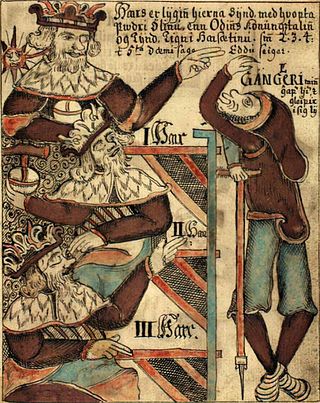
Læraðr (Laerad) is a tree in Norse mythology, often identified with Yggdrasil. It stands at the top of the Valhöll. Two animals, the goat Heiðrún and the hart Eikþyrnir, graze its foliage.

Læraðr (Laerad) is a tree in Norse mythology, often identified with Yggdrasil. It stands at the top of the Valhöll. Two animals, the goat Heiðrún and the hart Eikþyrnir, graze its foliage.
The meaning of Læraðr / Léraðr is unclear. One of the meanings of læ is "harm", "betrayal". A possible translation of Læraðr could therefore be "arranger of betrayal", which would relate to Yggdrasill as the place of Odin's self-sacrifice. [1] Another reading is sometimes suggested, *hléradr, whose first component means "shelter" and which could thus be rendered as "giver of protection". [2]
Læraðr is mentioned in two stanzas of the Grímnismál :
Under the name Léraðr, it also appears in Gylfaginning:
According to John Lindow, the first reason to identify Lærad with Yggdrasill is "Lærad's location at Odin's hall, which would be at the center of the cosmos". [1] Another argument is that many animals dwell in or around Yggdrasill, such as an eagle, the squirrel Ratatoskr, four stags, many snakes and the dragon Níðhöggr. Snorri also wrote that Hvergelmir was located under Yggdrasill (Gylfaginning, 15, 16).
Breiðablik is the home of Baldr in Nordic mythology.
Hvergelmir is an important primal wellspring in Norse mythology. Hvergelmir is attested in the Poetic Edda, compiled in the 13th century from earlier traditional sources, and the Prose Edda, written in the 13th century by Snorri Sturluson. In the Poetic Edda, Hvergelmir is mentioned in a single stanza, which details that it is the location where liquid from the antlers of the stag Eikþyrnir flow, and that the spring, "whence all waters rise", is the source of numerous rivers. The Prose Edda repeats this information and adds that the spring is located in Niflheim, that it is one of the three major springs at the primary roots of the cosmic tree Yggdrasil, and that within the spring are a vast amount of snakes and the dragon Níðhöggr.

In Norse cosmology, Niflheim or Niflheimr is a location which sometimes overlaps with the notions of Niflhel and Hel. The name Niflheimr appears only in two extant sources: Gylfaginning and the much-debated Hrafnagaldr Óðins.

In Norse mythology, Ratatoskr is a squirrel who runs up and down the world tree Yggdrasil to carry messages between the eagles perched atop it and the serpent Níðhöggr who dwells beneath one of the three roots of the tree. Ratatoskr is attested in the Poetic Edda, compiled in the 13th century from earlier traditional sources, and the Prose Edda, written in the 13th century by Snorri Sturluson.

In Norse mythology, Valhalla is described as a majestic hall located in Asgard and presided over by the god Odin. Half of those who die in combat enter Valhalla, while the other half are chosen by the goddess Freyja to reside in Fólkvangr. The masses of those killed in combat along with various legendary Germanic heroes and kings, live in Valhalla until Ragnarök when they will march out of its many doors to fight in aid of Odin against the jötnar.

Yggdrasil is an immense and central sacred tree in Norse cosmology. Around it exists all else, including the Nine Worlds.
In Norse mythology, Níðhöggr is a dragon who gnaws at a root of the world tree, Yggdrasil. In historical Viking society, níð was a term for a social stigma, implying the loss of honor and the status of a villain. Thus, its name might refer to its role as a horrific monster in its action of chewing the corpses of the inhabitants of Náströnd: those guilty of murder, adultery, and oath-breaking.
In Norse mythology, Sæhrímnir is the creature killed and eaten every night by the Æsir and einherjar. The cook of the gods, Andhrímnir, is responsible for the slaughter of Sæhrímnir and its preparation in the cauldron Eldhrímnir. After Sæhrímnir is eaten, the beast is brought back to life again to provide sustenance for the following day. Sæhrímnir is attested in the Poetic Edda, compiled in the 13th century from earlier traditional material, and the Prose Edda, written in the 13th century by Snorri Sturluson.

Heiðrún or Heidrun is a nanny goat in Norse mythology, that consumes the foliage of the tree Læraðr and produces mead from her udders for the einherjar. She is described in the Poetic Edda and Prose Edda.
Bestla is a jötunn in Norse mythology, and the mother of the gods Odin, Vili and Vé. She is also the sister of an unnamed man who assisted Odin, and the daughter of the jötunn Bölþorn. Odin is frequently called "Bestla's son" in both skaldic verses and the Poetic Edda.

In Norse mythology, Fólkvangr is a meadow or field ruled over by the goddess Freyja where half of those that die in combat go upon death, whilst the other half go to the god Odin in Valhalla. Others were also brought to Fólkvangr after their death; Egils Saga, for example, has a world-weary female character declare that she will never taste food again until she dines with Freyja. Fólkvangr is attested in the Poetic Edda, compiled in the 13th century from earlier traditional sources, and the Prose Edda, written in the 13th century by Snorri Sturluson. According to the Prose Edda, within Fólkvangr is Freyja's hall Sessrúmnir. Scholarly theories have been proposed about the implications of the location.
In Norse mythology, Borr or Burr was the son of Búri. Borr was the husband of Bestla and the father of Odin, Vili and Vé. Borr receives mention in a poem in the Poetic Edda, compiled in the 13th century from earlier traditional material, and in the Prose Edda, composed in the 13th century by Icelander Snorri Sturluson. Scholars have proposed a variety of theories about the figure.

Norse cosmology is the account of the universe and its laws by the ancient North Germanic peoples. The topic encompasses concepts from Norse mythology, such as notations of time and space, cosmogony, personifications, anthropogeny, and eschatology. Like other aspects of Norse mythology, these concepts are primarily recorded from earlier oral sources in the Poetic Edda, a collection of poems compiled in the 13th century, and the Prose Edda, authored by Icelander Snorri Sturluson in the 13th century. Together these sources depict an image of Nine Worlds around a cosmic tree, Yggdrasil.

In Norse mythology, four stags or harts eat among the branches of the world tree Yggdrasill. According to the Poetic Edda, the stags crane their necks upward to chomp at the branches. The morning dew gathers in their horns and forms the rivers of the world. Their names are given as Dáinn, Dvalinn, Duneyrr and Duraþrór. An amount of speculation exists regarding the deer and their potential symbolic value.

Eikþyrnir or Eikthyrnir is a stag which stands upon Valhalla in Norse mythology.
In Norse mythology, Barri is the place where Freyr and Gerðr are to consummate their union, as stated in the Skírnismál:

In Norse mythology, Himinbjörg is the home of the god Heimdallr. Himinbjörg is attested in the Poetic Edda, compiled from earlier traditional sources, and the Prose Edda and Heimskringla, both written in the 13th century by Snorri Sturluson. Himinbjörg is associated with Heimdallr in all sources. According to the Poetic Edda, Heimdallr dwells there as watchman for the gods and there drinks fine mead, whereas in the Prose Edda Himinbjörg is detailed as located where the burning rainbow bridge Bifröst meets heaven. Scholars have commented on the differences between the two attestations and linked the name of the mythical location to various place names.
Gjöll is the river that separates the living from the dead in Norse mythology. It is one of the eleven rivers traditionally associated with the Élivágar, rivers that existed in Ginnungagap at the beginning of the world.
The Horses of the Æsir are horses present in Norse mythology which are ridden by the Æsir. Their main purpose is to be ridden daily to Yggdrasil in order for their riders to pass judgements. They are said to cross Bifröst along their journey. Among them is the famous Sleipnir which is the strongest one. They are mentioned in the Poetic Edda and the Prose Edda.

Hár, Jafnhár, and Þriði are three men on thrones who appear in the Prose Edda in the Gylfaginning, one of the oldest and most important sources on Norse mythology. Their names translate as High, Just-as-High, and Third in Old Norse, respectively. In the story, King Gylfi, calling himself Gangleri, engages in a test of wisdom with the three, asking them detailed questions about the Æsir, their deeds, and their future. The three respond until the final segment, in which the three men and the great hall suddenly disappear.